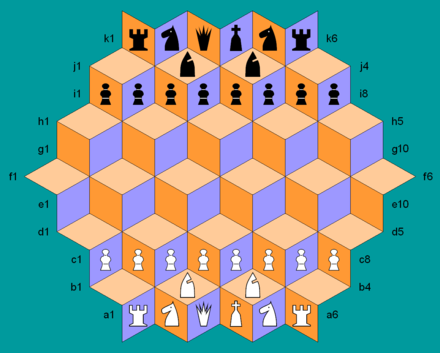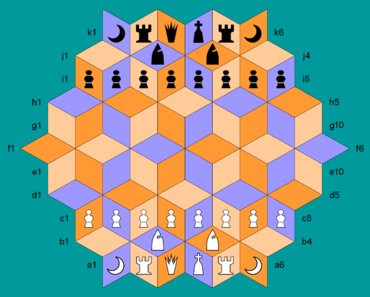Rhombic Chess
 Rhombic Chess
Rhombic Chess starting setup. Each side commands a standard set of chess pieces. Cell colors highlight
pointwise movement.
Rhombic Chess is a chess variant for two players created by Tony Paletta in 1980. The gameboard has an overall hexagonal shape and comprises 72 rhombi in three alternating colors. Each player commands a full set of standard chess pieces.
The game was first published in Chess Spectrum Newsletter 2 by the inventor. It was included in World Game Review No. 10 edited by Michael Keller.
Game rules
The diagram shows the starting setup. As in standard chess, White moves first and checkmate wins the game. Piece moves are described using two basic types of movement:
- Edgewise - through the common side of adjoining cells. If an edgewise move is more than one step, it continues in a straight line from the side of a cell through its opposite side, the line being orthogonal to these sides.
- Pointwise - through the sharpest corner of a cell, in a straight line to the next cell. (The paths are highlighted on the board by same-colored cells.)
Piece moves
- A rook moves edgewise only.
- A bishop moves pointwise. It can also move one step edgewise.
- The queen moves as a rook and bishop.
- The king moves one step edgewise or pointwise. There is no castling in Rhombic Chess.
- A knight moves in the pattern: one step edgewise followed by one step pointwise (or vice versa), away from its starting cell. Like a standard chess knight, it leaps any intervening men.
- A pawn moves forward one step edgewise, with the option of two steps on its first move. A pawn captures the same as it moves. There is no en passant in Rhombic Chess. A pawn promotes to any piece other than king when reaching rank i (for White) and rank c (for Black).
Parachess
 Parachess
Parachess starting setup. Each army includes two sorcerers. Cell colors highlight
arcwise and
wavepath movements.
Circa 2000, Paletta created Parachess using the same board geometry but introducing additional ways to move:
- An arcwise step - through the sharpest corner of a cell, to a cell not connected to the starting cell edgewise or pointwise.
- A wavepath move - a series of arcwise steps, with each step in the opposite direction of the preceding step.
These ways to move are highlighted on the board by same-colored cells.
Piece moves
- A rook moves edgewise only (as in Rhombic Chess).
- A bishop moves pointwise (as in Rhombic Chess) or along a wavepath.
- The queen moves as a rook and bishop.
- The king moves one step edgewise, pointwise, or arcwise. As in Rhombic Chess, there is no castling.
- The sorcerer moves in the pattern: one step pointwise, followed by one step edgewise or arcwise, or vice versa. It leaps any intervening men.
- A pawn moves forward one step edgewise, pointwise, or arcwise; there is no initial two-step option. A pawn captures forward one step edgewise or pointwise. There is no en passant. A pawn must reach the opponent's furthest rank in order to promote.
COMMENTS














 Rhombic Chess starting setup. Each side commands a standard set of chess pieces. Cell colors highlight pointwise movement.
Rhombic Chess starting setup. Each side commands a standard set of chess pieces. Cell colors highlight pointwise movement. Parachess starting setup. Each army includes two sorcerers. Cell colors highlight arcwise and wavepath movements.
Parachess starting setup. Each army includes two sorcerers. Cell colors highlight arcwise and wavepath movements.